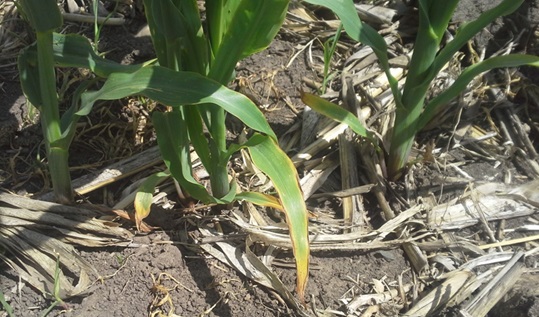By Anthony Bly, Extension Soils Field Specialist; David Karki, Extension Agronomy Field Specialist

Observations of corn with necrosis (yellowing) of lower leaf margins were reported in northeast S.D.. After investigating the field areas and reviewing soil and plant tissue analyses, potassium (K) deficiency was identified as the cause (see photo above). However, some of these fields had adequate fall and spring soil test potassium levels.
Two of the fields were recently resampled and analyzed for potassium, and their potassium levels dropped drastically when compared to previous samples from the same field (Table 1). One would ask, how could this happen?

Table 1. Potassium soil test level changes in pre- and post-planting soil samples in northeast South Dakota in 2016.
Dry Soil & Potassium Deficiency
Soil cations such as K are positively charged ions, and are held to the soil clay particles because the broken and weathered edges of the clay are negatively charged. Clay particles in the soil are very small and mostly like small platelets and occur in layers due to particle charge arrangements. The large surface area of the clay particles gives soil a great ability to hold and exchange cations, which is known as cation exchange capacity (CEC).
When the soil is moist or wet, it swells due to water in between these clay particle layers. When the soil dries, these clay layers shrink and the soil visually cracks. During extreme soil drying, the shrinking clay layers actually trap the cations, which become unavailable for plant roots to take up.
Al Huer, South Dakota State University Northeast Research Farm manager near South Shore, reported that while April’s precipitation was 0.30 inches above normal, May (1.45 inches) and June (0.42 inches) precipitation totals were only 35% of normal.
There isn’t much that can be done to alleviate the problem when surface soil moisture is very low. Applying extra K is problematic because of difficulty in getting a meaningful amount in the plant. Corn at V8 contains about 20-40 pounds per acre of K2O while a fully mature 150-bushel-per-acre corn contains about 225 pounds per acre of K2O.
Management Considerations
Foliar application of K can be problematic because when drought conditions occur, the plant leaf stomates (openings) tend to close for moisture conservation. Further, leaf surfaces are waxy and are not intended for large nutrient absorption, which is the function of the roots. Broadcast applications of K in large corn could cause plant damage due to fertilizer going down the leaf whorls. Potassium fertilizer rescue applications have been shown to work in research plots when soil moisture was adequate.
When limited soil moisture conditions occur, the worst of everything is brought out in a crop, including nutrient deficiency symptoms such as K.





